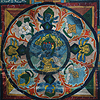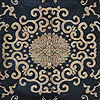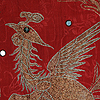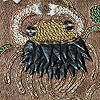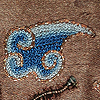 |

3100
Antique Chinese Silk Embroidery made in China for Tavora family of Portuguese Silk Velvet with Gold Embroidery Table Runner
1590 -1759 A.D
Circa 1650
Size 33" x 21"
Size 84 x 54cm
We have three pieces
Top Images are Details
This piece is a fine example of decorative Chinese textiles ordered by the Portuguese in the 17th Century. It is also a testimony of an important historical incident in Portugal known as referring to a political scandal in the middle 18th century.
History of the Object
Table cloth belonging to a set of two, with traces of a coat of arms ordered for the Távora family from China. Known as “the Távora table cloths” having been the property of the Távora family, they were confiscated by the Portuguese Royal House when the Marquis of Távora was accused of attempting to kill the King José I of Portugal. In the centre of the velvet cloth are the marks left from the coat of arms of the Távoras, destroyed when the cloths were confiscated by the Royal Family.
Below Similar piece at Ajuda National Palace

|
 |
An Important 17th Century Velvet Embroidery
 1759: The Tavora family
1759: The Tavora family
Two and a half centuries ago today, Portugal’s noble Tavora family was extirpated in Belem.
[A] scaffold eighteen feet in height was erected in the market-place of Lisbon, during the night of the 13th, round which was drawn up a cordon of military. Precisely at 7 o’clock in the morning, the old Marchioness of Tavora, as the most guilty, was brought upon the scene, her hands bound, and a rope round her neck. She was placed on a chair, and her eyes being bound, the executioner struck her head off without the previous utterance by her of any complaint. After her came the twenty-one-year-old son, Joseph Maria de Tavora. They bound him on a cross raised aloft, broke his arms and legs with iron clubs, and then strangled him with a rope. The same fate befell [Tavora son-in-law] Jeronimo de Ataide, Count of Atouguia, the young Marquis Luiz Bernard de Tavora, colonel of cavalry, his servant Blasius Joseph Romeiro, Corporal Emanuel Alvarez Fereira, valet of the Duke of Aveira, and the body-page, John Michael. Their corpses were all flattened upon wheels, which were placed on poles, and this proceeding took up so much time that fully half an hour elapsed before another execution could be proceeded with. After the page Miguel or Michael, the executioner took the old Francis d’Assis de Tavora, bound him on a St. Andrew’s cross, gave him three blows on the chest with an iron rod that resounded to a distance, shattered his arms and legs, and then gave him his coup de grace through the heart. The executioner’s men then, amidst wild shrieks, shattered the arms, legs, and thighs of the ninth victim, the old Duke of Aveiro, while still alive, then killed him by a blow on the chest, and threw him into the blazing fire. Finally, the tenth delinquent, the valet Anton Alvarez Fereira, brother of the above-mentioned Emanuel, was conducted before the corpses of the nine who had been previously executed, each one being shown to him; he was then bound to a stake, round which was placed a heap of wood, and this being set fire to, was raked together until he was completely consumed* … When the execution was over, the scaffold, together with all the dead bodies, was set on fire and burnt to ashes, which were thrown into the Tagus.
Other outstandingly gory images of this day’s business are here.
Oh, and one last thing:
[T]he palaces of the high nobility who had been executed were pulled to pieces and levelled to the ground, and salt strewed on the places where they had stood, as a sign that they should never be built up again.
Yikes.
This stone marker was placed on the site of the razed palace of Jose Mascarenhas, the Duke of Aveiro. “On this infamous land,” it announces, “nothing may be built for all time.” Copyrighted image courtesy of Ludgero Paninho.
Seems someone got the idea that the Tavoras tried to kill (and more problematically, failed to kill) Portuguese king Joseph I.
Circumstantial, torture-adduced evidence put the scheming Marchioness Eleonora de Tavora and clan behind an apparent assassination attempt, wherein a couple of assailants had shot at the king’s unmarked carriage as it returned on a little-used road from a rendezvous with his mistress. (One of the circumstances was that the mistress was a Tavora, which put the accused in a position to know the king’s secret travel plans. Others argue the gunmen might have just been common highwaymen who had no idea they were setting upon the royal person.)
Whatever the facts of the matter, obscure behind a quarter-millennium, its attribution to the Tavoras and the spectacular revenge thereupon visited was effected by the king’s competent and ruthless minister, Sebastião José de Carvalho e Melo, the future Marquis de Pombal.
A monumental plinth surmounted by Pombal dominates the present-day Lisbon plaza named for him.
His able handling of the recent Lisbon earthquake had cemented his position as the throne’s right-hand man in a trend of centralizing absolutism not much appreciated by the old aristocracy (nor by the hidebound clerical orders, which explains why the aforesaid gory account of the execution ground comes from a German anti-Jesuit polemic).
And he would not miss the opportunity an attack on the king’s person gave him to sweep away his opponents.
The peers of the realm were summoned to witness their fellow blue-bloods so nauseatingly dispatched, and the Jesuits — “reported to have inflamed the Tavora family to their [the Jesuits’] desired pitch … in revenge for what had justly been done to them in South America”** — were forthwith suppressed.
(Functionally a progressive secular dictator — or an enlightened despot, to use a more 18th-century description — Pombal would eventually push political conflict with Rome so near the brink of outright schism that the Catholic Encyclopedia’s entry on Melo characterizes it as “a sort of disguised Anglicanism,” adding that “many of the evils from which the Church now suffers are a legacy from him.” His ascendancy is the “Pombaline Terror” in Catholic annals.)
Melo/Pombal exercised the power of the state for the rest of Joseph’s life, but the king’s daughter and successor Maria I dismissed him — though she did not take punitive action against Pombal for his persecutions, as his enemies demanded.
* Also doomed to burning alive was one Joseph Policarpo, who was able to escape the mass arrest a few weeks before and fled the kingdom. He was executed by effigy.
** This comment is from the letters of Christopher Hervey, an Englishman abroad in Portugal at the time of the execution whose 100+ pages’ worth of correspondence include live-at-the-scene reporting and English translations of the public pronouncements against the supposed culprits. As to the South American roots of Pombal’s conflict with the Jesuits, the order had resisted Pombal’s early schemes to reorganize and rationalize Portugal’s New World holdings in order to make the country a more competitive colonial power. Jesuit resistance to giving up the order’s control of education, and its humanitarian efforts to protect Indians, had been seen as contributing to an Indian rebellion that broke out in Jesuit-controlled territory — even to the point that Jesuits themselves were suspected of arming Indians in an effort to carve out church-controlled states. Hervey’s version has the Jesuits behind the plot in order to eliminate Pombal’s threat to their power. Others share this opinion … and Pombal, obviously, was keen to have his rivals inculpated for lese majeste in the public mind.
Alors que le roi D. José I rentre tard au palais, d’une visite à sa maitresse, l’épouse d’un des héritiers de la puissante famille Távora, trois chevaliers s’attaquent à l’équipage. Le roi aurait été blessé à un bras mais on a déclaré qu’il avait été grièvement blessé.
Le premier ministre de l’époque, Sebastião José de Carvalho e Melo, s’est lancé à la poursuite des auteurs de l’attentat et après l’arrestation et la torture de deux malfrats, on raconte que ceux-ci auraient prétendu avoir agi sur les ordres de la famille Távora. Ils ont été tous deux pendus le lendemain de leur confession.
Dès lors, la haine affiché qu’un homme avait pour l’ancien vice-roi des Indes et sa famille a suffi a transformer les soupçons en preuves irréfutables.
La confession de deux malfrats déjà exécutés; l’arme du crime qu’on disait avoir appartenu à un des membres de la famille Távora et puis, preuve des preuves, le fait qu’ils étaient tous aux courant des incartades du roi avec Teresa de Távora à qui d’ailleurs on n’a pas épargné l’emprisonnement pour complicité.
Aussitôt, et en mépris du Tribunal régulier qui ne fut même pas consulté, on nomma une commission de magistrats qui jugèrent, le 12 septembre 1758, les accusés au cours d’un procès intime et sommaire.
Les Távora ont beau nier toutes les accusations et s’épuiser à argumenter et tenter de faire preuve de leur innocence, ça été peine perdue. Ils ont tous été, y compris femmes et enfants, condamnés à mort, avec châtiment public préalable.
Ils ont aussi pris connaissance que tous leurs biens avaient été confisqués au bénéfice de la couronne. Leurs noms effacés de la noblesse et leurs insignes de famille, interdits. Leur palais serait brulée et le terrain salé pour rendre le lieu stérile. D’ailleurs, à Belém, ou trouve une colonne où on pourra lire Ici ont été détruites et salées les maisons de José de Mascarenhas ex-Duc d’Aveiro et autres et condamné par sentence par la commission suprême le 12 janvier 1758 faisant justice à une attaque barbare dans la nuit du 13 septembre 1758 contre la personne royale et sacrée de notre seigneur le roi D. José. Sur ce terrain infâme on ne pourra plus construire, pendant un certain temps.
Le lendemain, le 13 janvier 1758, par la folie d’un homme, le Portugal allait inscrire dans son histoire, une des pages les plus sanglantes, inhumaines et barbares de son histoire.
La marquise de Távora fut décapitée après qu’on lui ait expliqué, avec lenteur et un cruel souci du détail, la manière avec laquelle on allait procéder avec ses proches, époux, fils, gendres.
On lui montre les instruments avec lesquels ils allaient être suppliciés et horreur inimaginable, on lui explique les douleurs et les souffrances atroces que cela allait engendrer avant leur mort.
Six heures durant, le roi et la cour ont assisté au châtiment exemplaire, qui devait montrer à un peuple apeuré que même les nobles étaient durement châtiés. Le roi n’épargnait personne.
L’histoire retient encore que le père jésuite, Gabriel Malagrida, ami personnel et confesseur de la marquise de Távora, a été brulé vif quelques jours après et que l’ordre des Jésuites a été déclaré illégal et le Marquis de Pombal se fait une joie personnelle d’expulser les jésuites du Portugal. Il se vantera d’ailleurs que cette expulsion est son cadeau au Pape Clément XII.
Sebastião José de Carvalho e Melo a été anobli avec le titre de Comte de Oeiras, en reconnaissance de sa compétence démontrée dans le traitement du procés des Távora. En 1770, il obtient le titre de Marquis de Pombal.
La future reine du Portugal, D. Maria I, profondément bouleversée par ce procès et sa barbarie, a, lors de son arrivée au pouvoir, demandé qu’un vrai procès puisse avoir lieu et que celui-ci soit revu par le Tribunal et mettra le très puissant Marquis à l’écart de la couronne et de l’état.
Vingt-deux ans plus tard, jamais aucune preuve n’est venue démontrer la culpabilité des Távora dans l’attentat. A vrai dire, même certains historiens, après des années de recherches, ne croient guère à la culpabilité des Távora.
Dès 1822, on a inscrit dans la Constitution portugaise l’abolition de toutes les peines cruelles et infamantes, mais c’est seulement en 1867, pendant le règne de D. Louis Ier, que l’abolition de la peine de mort est définitivement inscrite au code pénal portugais.
|
 |


